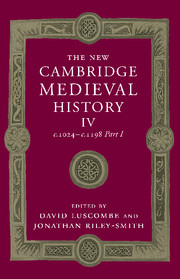Book contents
- Frontmatter
- 1 Introduction
- 2 The Rural Economy and Demographic Growth
- 3 Towns and the Growth of Trade
- 4 Government and Community
- 5 The Development of Law
- 6 Knightly Society
- 7 War, Peace and the Christian Order
- 8 The Structure of the Church, 1024–1073
- 9 Reform and the Church, 1073–1122
- 10 Religious Communities, 1024–1215
- 11 The Institutions of the Church, 1073–1216
- 12 Thought and Learning
- 13 Religion and the Laity
- 14 The Crusades, 1095–1198
- 15 The Eastern Churches
- 16 Muslim Spain and Portugal: Al-Andalus and its Neighbours
- 17 The Jews in Europe and the Mediterranean Basin
- 18 Latin and Vernacular Literature
- 19 Architecture and the Visual Arts
- List of Primary Sources
- Bibliography of secondary works arranged by chapter
- Index
- Frontispiece">
- Plate section"
- References
7 - War, Peace and the Christian Order
Published online by Cambridge University Press: 28 March 2008
- Frontmatter
- 1 Introduction
- 2 The Rural Economy and Demographic Growth
- 3 Towns and the Growth of Trade
- 4 Government and Community
- 5 The Development of Law
- 6 Knightly Society
- 7 War, Peace and the Christian Order
- 8 The Structure of the Church, 1024–1073
- 9 Reform and the Church, 1073–1122
- 10 Religious Communities, 1024–1215
- 11 The Institutions of the Church, 1073–1216
- 12 Thought and Learning
- 13 Religion and the Laity
- 14 The Crusades, 1095–1198
- 15 The Eastern Churches
- 16 Muslim Spain and Portugal: Al-Andalus and its Neighbours
- 17 The Jews in Europe and the Mediterranean Basin
- 18 Latin and Vernacular Literature
- 19 Architecture and the Visual Arts
- List of Primary Sources
- Bibliography of secondary works arranged by chapter
- Index
- Frontispiece">
- Plate section"
- References
Summary
in the eleventh and twelfth centuries, ‘Latin’ Europe went through a period of growing social differentiation, in which the function of each class became more clearly defined. The king was seen as the holder of an office, the discharge of which must answer to a basically Christian ordering of affairs. The warrior class emerged as a group whose position in society was determined by their ability and duty to bear arms, which gave them a claim to nobility. Differentials in the religious life emerged with the monastic reforms originating in Cluny and the development of new religious orders: Cistercians, Premonstratensians and canons. Religion also became more strongly centred on the Roman church and the pope. The interaction of these processes of transformation, within aristocratic and chivalric society on the one hand and the church on the other, gave rise to a new phenomenon in medieval history: the crusades. What was new was not so much the adoption of war to a religious context as the fact that the pope was summoning the whole of western Christendom to war: to a certain extent, western Christendom constituted itself as such by going jointly to war. No longer was individual withdrawal from the world into the cloister the sole representation of the ideal Christian life. Rather did war, a worldly activity, and the Christian life come together in a previously unknown relationship, no longer opposed one to the other. Fighting, which had previously been a way for the individual to rise above the mass of the population, shook free of this orientation and became part of a greater whole.
- Type
- Chapter
- Information
- The New Cambridge Medieval History , pp. 185 - 228Publisher: Cambridge University PressPrint publication year: 2004
References
- 2
- Cited by

